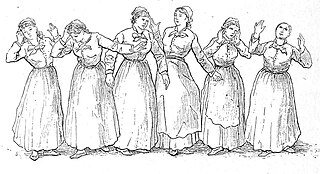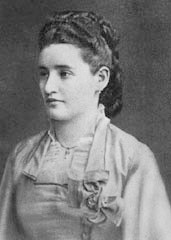The hypnoid state is a theory of the origins of hysteria published jointly by Josef Breuer and Sigmund Freud in their Preliminary communication [1] of 1893, subsequently reprinted as the first chapter of Studies on Hysteria (1895). [2]
For Breuer and Freud, who characterised the hypnoid state as a state of absence of mind/consciousness produced by intense daydreams of a mournful or sexual nature, "the existence of hypnoid states forms the foundation and condition of hysteria". [3]
The hypnoid state was seen as one resembling but not identical with hypnosis. [4] In the hypnoid state, one may have dream-like experiences. [4] One enters the hypnoid state by either hypnosis or by voluntary amnesia. [4]
Breuer credited Paul Julius Möbius as a forerunner in the development of the idea. [5]
Freud was shortly to repudiate the causative notion of hypnoid states, in favour of his theory of psychological repression. [6] As he would put it later, "Breuer's theory of 'hypnoid states' turned out to be impeding and unnecessary, and it has been dropped by psycho-analysis today...the screen of hypnoid states erected by Breuer". [7]
Nevertheless he continued to recognise the importance of such states of absent consciousness in the symptomatology of the hysterical subject. [8]

Psychoanalysis is a set of theories and therapeutic techniques used to study the unconscious mind, which together form a method of treatment for mental disorders. The discipline was established in the early 1890s by Austrian neurologist Sigmund Freud, who retained the term psychoanalysis for his own school of thought. Freud's work stems partly from the clinical work of Josef Breuer and others. Psychoanalysis was later developed in different directions, mostly by students of Freud, such as Alfred Adler and his collaborator, Carl Gustav Jung, as well as by neo-Freudian thinkers, such as Erich Fromm, Karen Horney, and Harry Stack Sullivan.

Sigmund Freud was an Austrian neurologist and the founder of psychoanalysis, a clinical method for treating psychopathology through dialogue between a patient and a psychoanalyst.
Psychoanalytic theory is the theory of personality organization and the dynamics of personality development that guides psychoanalysis, a clinical method for treating psychopathology. First laid out by Sigmund Freud in the late 19th century, psychoanalytic theory has undergone many refinements since his work. Psychoanalytic theory came to full prominence in the last third of the twentieth century as part of the flow of critical discourse regarding psychological treatments after the 1960s, long after Freud's death in 1939. Freud had ceased his analysis of the brain and his physiological studies and shifted his focus to the study of the mind and the related psychological attributes making up the mind, and on treatment using free association and the phenomena of transference. His study emphasized the recognition of childhood events that could influence the mental functioning of adults. His examination of the genetic and then the developmental aspects gave the psychoanalytic theory its characteristics. Starting with his publication of The Interpretation of Dreams in 1899, his theories began to gain prominence.

Hysteria is a pejorative term that colloquially means ungovernable emotional excess and can refer to a temporary state of mind or emotion. In the 19th century, hysteria was considered a diagnosable physical illness in females. In the 20th century, it shifted to being considered a mental illness. Many influential persons such as Sigmund Freud and Jean-Martin Charcot dedicated research to hysteria patients. Currently, most doctors practicing Western medicine do not accept hysteria as a medical diagnosis. The blanket diagnosis of hysteria has been fragmented into a myriad of medical categories such as epilepsy, histrionic personality disorder, conversion disorders, dissociative disorders, or other medical conditions. Furthermore, social deviances, such as deciding not to wed, are no longer considered symptoms of psychological disorders such as hysteria.
Free association is the expression of the content of consciousness without censorship as an aid in gaining access to unconscious processes. The technique is used in psychoanalysis which was originally devised by Sigmund Freud out of the hypnotic method of his mentor and colleague, Josef Breuer.

Anna O. was the pseudonym of a patient of Josef Breuer, who published her case study in his book Studies on Hysteria, written in collaboration with Sigmund Freud. Her real name was Bertha Pappenheim (1859–1936), an Austrian-Jewish feminist and the founder of the Jüdischer Frauenbund.
In psychology, the subconscious is the part of the mind that is not currently in focal awareness.

Josef Breuer was a distinguished physician who made key discoveries in neurophysiology, and whose work in the 1880s with his patient Bertha Pappenheim, known as Anna O., developed the talking cure and laid the foundation to psychoanalysis as developed by his protégé Sigmund Freud.
Repression is the psychological attempt to direct one's own desires and impulses toward pleasurable instincts by excluding them from one's consciousness and holding or subduing them in the unconscious. According to psychoanalytic theory, repression plays a major role in many mental illnesses, and in the psyche of the average person.
The Nancy School was a French hypnosis-centered school of psychotherapy. The origins of the thoughts were brought about by Ambroise-Auguste Liébeault in 1866, in Nancy, France. Through his publications and therapy sessions he was able to gain the attention/support from Hippolyte Bernheim: another Nancy Doctor that further evolved Liébeault's thoughts and practices to form what is known as the Nancy School.

Pierre Marie Félix Janet was a pioneering French psychologist, physician, philosopher, and psychotherapist in the field of dissociation and traumatic memory.
The Talking Cure and chimney sweeping were terms Bertha Pappenheim, known in case studies by the alias Anna O., used for the verbal therapy given to her by Josef Breuer. They were first published in Studies on Hysteria (1895).

Studies on Hysteria is an 1895 book by Sigmund Freud, the founder of psychoanalysis, and the physician Josef Breuer. It consists of a joint introductory paper ; followed by five individual studies of "hysterics" – Breuer's famous case of Anna O., seminal for the development of psychoanalysis, and four more by Freud— including his evaluation of Emmy von N— and finishing with a theoretical essay by Breuer and a more practice-oriented one on therapy by Freud.

Abraham Arden Brill was an Austrian-born psychiatrist who spent almost his entire adult life in the United States. He was the first psychoanalyst to practice in the United States and the first translator of Sigmund Freud into English.

Hippolyte Bernheim was a French physician and neurologist, born at Mülhausen, Alsace. He is chiefly known for his theory of suggestibility in relation to hypnotism.

Resistance, in psychoanalysis, refers to oppositional behavior when an individual's unconscious defenses of the ego are threatened by an external source. Sigmund Freud, the founder of psychoanalytic theory, developed his concept of resistance as he worked with patients who suddenly developed uncooperative behaviors during sessions of talk therapy. He reasoned that an individual that is suffering from a psychological affliction, which Freud believed to be derived from the presence of suppressed illicit or unwanted thoughts, may inadvertently attempt to impede any attempt to confront a subconsciously perceived threat. This would be for the purpose of inhibiting the revelation of any repressed information from within the unconscious mind.
In the psychoanalysis of Sigmund Freud, afterwardsness is a "mode of belated understanding or retroactive attribution of sexual or traumatic meaning to earlier events... [from the German word] Nachträglichkeit, translated as deferred action, retroaction, après-coup, afterwardsness". As summarized by another scholar, 'In one sense, Freud's theory of deferred action can be simply stated: memory is reprinted, so to speak, in accordance with later experience'.
The Standard Edition of the Complete Psychological Works of Sigmund Freud is a complete edition of the works of Sigmund Freud, the founder of psychoanalysis. It was translated from the German under the general editorship of James Strachey, in collaboration with Anna Freud, assisted by Alix Strachey and Alan Tyson. The Standard Edition consists of 24 volumes, and it was originally published by the Hogarth Press in London in 1953–1974. Unlike the German Gesammelte Werke, the SE contains critical footnotes by the editors. This editorial material has later been included in the German-language Studienausgabe edition of Freud.
Motivated forgetting is a theorized psychological behavior in which people may forget unwanted memories, either consciously or unconsciously. It is an example of defence mechanism, since these are unconscious or conscious coping techniques used to reduce anxiety arising from unacceptable or potentially harmful impulses thus it can be a defence mechanism in some ways. Defence mechanisms are not to be confused with conscious coping strategies.
This is a list of writings published by Sigmund Freud. Books are either linked or in italics.